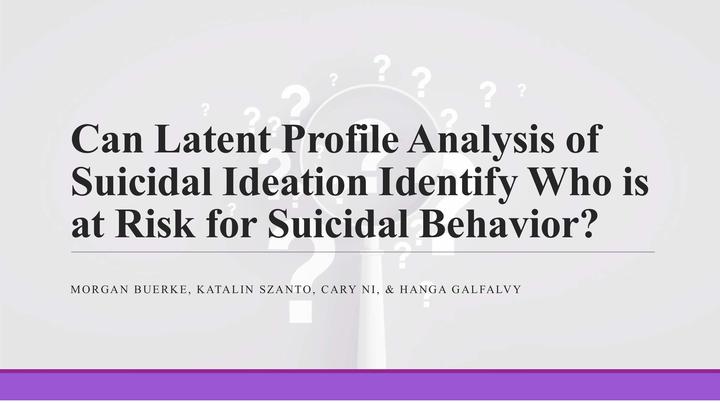Can Latent Profile Analysis of Suicidal Ideation Identify Who is at Risk for Suicidal Behavior?

Abstract
Suicidal ideation’s relationship with suicidal behavior has been well-established, but how suicidal ideation patterns over time can indicate risk has been less studied. Latent Profile Analysis (LPA) was used to identify patterns of suicidal ideation among 337 depressed older adults who received follow-up at least yearly for up to 14 years. Participant-level aggregates of suicidal ideation scores across follow-up periods were calculated, including mean, standard deviation, maximum, proportion of zeros, and root mean square of successive differences (i.e., difference from one timepoint to another) for two timeframes: current and worst since last seen. These were entered into an LPA alongside baseline and worst lifetime ideation (12 measures per participant), with the best profile solution chosen based on optimal Bayes Information Criterion. The four profiles were: 1) chronic severe, 2) highly variable, 3) fast-remitting, and 4) low/non-ideators. Risk for suicide attempt or suicide death during follow-up was compared using age-adjusted competing risk survival analysis. Depression severity was compared between groups using mixed effect regression models with a profile by depression interaction term. Spline functions separately assessed short and longer-term non-linear trends. Low/non-ideators had the lowest suicide risk of all groups with no suicidal behavior during the follow-up period. Risk for follow-up suicide attempt/death were significantly higher in chronic severe ideators (Hazard Ratio [HR]= 5.75; 95% CI, 2.25–14.7; p < .001) and highly variable ideators (HR = 3.21; 95% CI, 1.03–10.1; p = .045) compared to fast-remitting ideators, despite having similar suicidal ideation and depression severity at baseline. Depression severity decreased at similar rates across subtypes during the first 3 months of follow-up (group by time interaction p>0.05), but the strongest association between ideation and depression was found in the fast-remitting group, indicating that this group’s ideation remission may have been due to rapid depression symptom improvement. Chronic ideators’ depression remained highest in the first 5 years of follow-up, consistent with their high risk for suicidal behavior. Our findings indicate that LPA can aid our understanding of suicide risk factors. The resulting profiles can serve as a starting point for further analyses investigating profile-specific candidate mechanisms of this risk, which can lead to better targeted intervention strategies for suicide prevention.